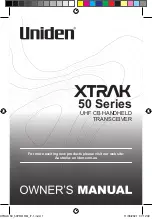
97
MODEL 5081-A
SECTION 15.0
TROUBLESHOOTING
SECTION 15.0
TROUBLESHOOTING
15.1 WARNING, FAULT, AND ERROR MESSAGES
15.2 TROUBLESHOOTING WHEN A WARNING OR FAULT MESSAGE IS SHOWING
15.3 TEMPERATURE MEASUREMENT AND CALIBRATION PROBLEMS
15.4 OxyGEN MEASUREMENT AND CALIBRATION PROBLEMS
15.5 FREE CHLORINE MEASUREMENT AND CALIBRATION PROBLEMS
15.6 TOTAL CHLORINE MEASUREMENT AND CALIBRATION PROBLEMS
15.7 OzONE MEASUREMENT AND CALIBRATION PROBLEMS
15.8 pH MEASUREMENT AND CALIBRATION PROBLEMS
15.9 SIMULATING INPUT CURRENTS - DISSOLvED OxyGEN
15.10 SIMULATING INPUT CURRENTS - CHLORINE AND OzONE
15.11 SIMULATING INPUTS - pH
15.12 SIMULATING TEMPERATURE
15.13 MEASURING REFERENCE vOLTAGE
15.1 WARNING, FAULT, AND ERROR MESSAGES
the Model 5081-A transmitter continuously monitors the sensor and transmitter for conditions that cause erroneous meas-
urements. When a problem occurs, the transmitter displays either a warning or fault message. A warning alerts the user
that a potentially disabling condition exists. there is a high probability that the measurement is in error. A fault alerts the
user that a disabling condition exists. If a fault message is showing, all measurements should be regarded as erroneous.
When a WARNING condition exists:
1. the main display remains stable; it does not flash.
2. A warning message appears alternately with the temperature and output readings in the second line of the display. See
Section 15.4 for an explanation of the warning messages and suggested ways of correcting the problem.
When a FAULT exists:
1. the main display flashes.
2. the words FAuLt and HoLd appear in the main display.
3. A fault message appears alternately with the temperature and output readings in the second line of the display. See
Section 15.4 for an explanation of the fault messages and suggested ways of correcting the problem.
4. the output current will remain at the present value or go to the programmed fault value. See Section 7.3 for details on
how to program the current generated during a fault condition.
5. If the transmitter is in HoLd when the fault occurs, the output remains at the programmed hold value. to alert the user
that a fault exists, the word FAuLt appears in the main display, and the display flashes. A fault or diagnostic message
also appears.
6. If the transmitter is simulating an output current when the fault occurs, the transmitter continues to generate the sim-
ulated current. to alert the user that a fault exists, the word FAuLt appears in the display, and the display flashes.
When an ERROR exists:
1. the main display remains stable; it does not flash.
2. A description of the error appears. Error messages typically appear during calibration.
















































